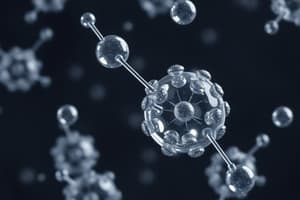Podcast
Questions and Answers
What size range defines nanoparticles used in advanced drug delivery?
What size range defines nanoparticles used in advanced drug delivery?
- 10-500 nanometers
- 500-2000 nanometers
- 1-10 nanometers
- 1-1000 nanometers (correct)
Nanoparticles are primarily used to decrease drug effectiveness and increase side effects.
Nanoparticles are primarily used to decrease drug effectiveness and increase side effects.
False (B)
Name three types of nanoparticles used in drug delivery.
Name three types of nanoparticles used in drug delivery.
Liposomes, Polymeric nanoparticles, solid lipid nanoparticles, gold nanoparticles, dendrimers
The surface charge and _________ of nanoparticles are key for interaction with biological systems.
The surface charge and _________ of nanoparticles are key for interaction with biological systems.
Match the following nanoparticle drug delivery mechanisms with their descriptions:
Match the following nanoparticle drug delivery mechanisms with their descriptions:
What potential toxicity concern is associated with the small size of nanoparticles?
What potential toxicity concern is associated with the small size of nanoparticles?
Regulatory approval for nanoparticles in medicine does not require strict testing due to their established safety.
Regulatory approval for nanoparticles in medicine does not require strict testing due to their established safety.
Describe one application of nanoparticles in medicine other than cancer therapy.
Describe one application of nanoparticles in medicine other than cancer therapy.
___________ is a top-down approach that uses mechanical grinding to reduce particle size to nanoscale.
___________ is a top-down approach that uses mechanical grinding to reduce particle size to nanoscale.
Which type of nanoparticle preparation method involves assembling nanoparticles from molecular or atomic units?
Which type of nanoparticle preparation method involves assembling nanoparticles from molecular or atomic units?
Flashcards
Nanoparticles
Nanoparticles
Tiny particles, ranging from 1-1000 nm, employed in advanced drug delivery systems.
Why are nanoparticles used in drug delivery?
Why are nanoparticles used in drug delivery?
Nanoparticles enhance drug effectiveness, reduce side effects, and improve targeting due to their unique properties.
Key Factors in Nanoparticle Design
Key Factors in Nanoparticle Design
Size (1-1000 nm), surface properties (charge and functionalization), and shape influence cell uptake and interaction with biological systems.
Liposomes & Niosomes
Liposomes & Niosomes
Signup and view all the flashcards
Polymeric Nanoparticles
Polymeric Nanoparticles
Signup and view all the flashcards
Passive Targeting
Passive Targeting
Signup and view all the flashcards
Active Targeting
Active Targeting
Signup and view all the flashcards
Nanoparticle Toxicity
Nanoparticle Toxicity
Signup and view all the flashcards
Nanoparticles in Cancer Therapy
Nanoparticles in Cancer Therapy
Signup and view all the flashcards
Top-Down Approaches
Top-Down Approaches
Signup and view all the flashcards
Study Notes
Nanoparticles in Drug Delivery
- Nanoparticles are small particles, sized 1-1000 nm, utilized in advanced drug delivery systems.
- Nanoparticles are a significant focus in advanced drug delivery due to their unique properties.
- Unique properties enhance drug effectiveness, reduce side effects, and improve targeting.
Key Factors in Nanoparticle Design
- Size (1-1000 nm) is crucial for cell uptake and targeting specific tissues.
- Surface charge, whether positive, negative, or neutral, and functionalization are key for interaction with biological systems.
- Functionalization targets specific cells or tissues.
- Shape influences how nanoparticles enter and move in the body.
- Spherical nanoparticles internalize more easily by cells.
- Rod-shaped particles may have different circulation times.
Types of Nanoparticles
- Liposomes & Niosomes encapsulate both hydrophilic and hydrophobic drugs and act as biocompatible carriers.
- Polymeric Nanoparticles are useful for controlled release and targeting.
- Solid Lipid Nanoparticles (SLNs) enhance solubility and drug release.
- Gold Nanoparticles are utilized in imaging and cancer treatment.
- Dendrimers are branched structures for precise drug loading.
Drug Release Mechanisms
- Passive Targetingaccumulates in tumors naturally due to the enhanced permeability and retention (EPR) effect.
- Active Targeting uses ligands, such as antibodies, to reach specific cells.
- Controlled Release responds to pH, temperature, or enzymes.
Challenges & Considerations
- Toxicity resulting from small size may cause unexpected interactions leading to cytotoxicity.
- Biodistribution must ensure correct targeting.
- Nanoparticles require stability in physiological conditions in the body.
- Regulatory Approval requires strict testing.
Applications in Medicine
- Cancer Therapy delivers chemotherapy directly to tumors.
- Gene Delivery transports DNA/RNA for gene therapy.
- Vaccines enhance immune response.
- Antibiotic Delivery improves drug effectiveness.
- Neurological Diseases treatments can cross the blood-brain barrier.
Commercial Examples
- Doxil® is liposomal doxorubicin for cancer treatment.
- Abraxane® is nanoparticle-bound paclitaxel for breast cancer treatment.
Nanoparticle Preparation: Top-Down Approaches
- Top-down methods involve breaking down larger particles or materials into smaller nanoparticles.
- High-Pressure Homogenization breaks down materials under pressure.
- Ball Milling uses mechanical grinding to reduce particle size.
- Laser Ablation uses laser to create nanoparticles from bulk material like metal, ceramic, or semiconductor.
Nanoparticle Preparation: Bottom-Up Approaches
- Bottom-up approaches involve assembling nanoparticles from molecular or atomic units, which allows for more control over particle properties.
- Solvent Evaporation forms polymeric nanoparticles by evaporating solvent from a solution containing the drug and a polymer.
- Emulsion Solvent Diffusion creates nanoparticles using an emulsion process.
- Precipitation Method / Solvent-antisolvent Method uses nanoprecipitation
- Coacervation or Phase Separation are also bottom-up approaches
Nanoparticle Preparation: Chemical Reactions
- Chemical reactions lead to nanoparticle formation.
- Chemical Vapor Deposition creates inorganic nanoparticles.
- Hydrothermal Synthesis is frequently used for the preparation of metal oxide nanoparticles, such as titanium dioxide and silica.
- Green Synthesis is used for the preparation of metal nanoparticles like gold and silver.
Nanoparticle Preparation: Electrostatic Methods and Electrospinning
- Electrostatic Methods assemble oppositely charged nanoparticles into larger structures by applying an electric field.
- Electrospinning is a technique where a polymer solution is subjected to an electric field to produce nanofibers or nanoparticles.
Studying That Suits You
Use AI to generate personalized quizzes and flashcards to suit your learning preferences.



